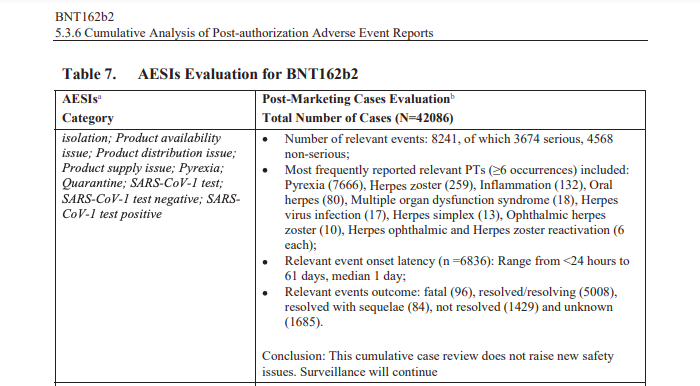Cases of Shingles Following COVID-19 Vaccination on the Rise, Studies Show

COVID-19 vaccines may be associated with yet another inconvenient side-effect that for most, is far worse than actually getting COVID. Doctors and scientists are reporting an increase in cases of shingles following COVID-19 vaccination, but U.S. health agencies continue to claim the shots don’t cause shingles and no safety signals have been detected.
Shingles and chicken pox are both caused by the varicella-zoster virus (VZV). Once you’ve had chickenpox, the virus lays dormant in the nerves of the spinal cord and can reactivate later in life as shingles.
Shingles, or herpes zoster (HZ), is a viral infection that causes a painful rash and most often appears as a single stripe of blisters that wraps around the torso.
Most people with shingles have one or more of the following symptoms: fluid-filled blisters, burning, shooting pain, tingling, itching, or numbness of the skin, chills, fever, headache or upset stomach.
The disease usually resolves in two to four weeks, but some people may experience complications such as persistent nerve pain, vision, or hearing loss and facial paralysis known Ramsay Hunt Syndrome.
According to NATURE, VZV is reactivated in around 30% of people as shingles, which causes a “painful rash and the potential for blindness, stroke or debilitating pain.”
U.S. health officials say there’s no correlation between COVID-19 vaccines and shingles, but this should not come as a surprise to anyone considering who funds the U.S. Food and Drug Administration (FDA) and the 1,307,928 adverse events they’re already ignoring attributed to COVID-19 vaccines.
The FDA claims it has “not detected any safety signals regarding shingles following approved or authorized COVID-19 vaccines,” The Epoch Times reported.
The Centers for Disease Control and Prevention (CDC) alleges “there is no current connection” between COVID-19 vaccines and the reactivation of VZV, but a recent Freedom of Information Act request showed the agency never analyzed the Vaccine Adverse Event Reporting System (VAERS) for safety signals for COVID-19 vaccines.
Scott Pauley, a CDC spokesperson, told the Epoch Times that any adverse reactions experienced after receiving the shot are temporary and a positive sign that the vaccine is working.
“Some people have side effects from the vaccine, which are normal signs that their body is building protection,” Pauley said. “These side effects may affect their ability to do daily activities, but they should go away in a few days. Some people have no side effects, and allergic reactions are rare.”
Yet, numerous studies show a higher incidence of shingles in people who received the vaccine.
A 2021 article reported two cases of shingles in adults after vaccination with Pfizer’s COVID-19 vaccine. In both cases, the individuals previously had chickenpox, which results from the same virus. Researchers theorized a possible cause for the reaction is a transient lymphocytopenia — lower levels of white blood cells — that occurs after the vaccination and can result in a shingles flare.
A study published April 2021 in Rheumatology reported a case series of six women out of 491 participants who developed shingles 3 to 14 das after receiving their first dose of Pfizer. The women who developed shingles had an autoimmune disorder and none of the 99 participants in the control group developed shingles.
The authors concluded:
“Epidemiologic studies on the safety of the mRNA-based COVID-19 vaccines in patients with AIIRD [autoimmune inflammatory rheumatic disease] are needed to clarify the association between the BNT162b2 mRNA vaccination and reactivation of zoster.”
In a case study from Taiwan, researchers reported three healthy men ages 71, 46 and 42 developed shingles two to seven days after the first dose of Moderna or AstraZeneca COVID-19 vaccines.
Researchers said HZ does “not often appear after the administration of other kinds of vaccinations,” but they “believed there might be a link between COVID-19 vaccine and HZ emergence.”
Another 2021 case study suggests an immune reaction following vaccination with Pfizer’s COVID-19 vaccine may allow VZV to escape from its latent phase and cause shingles.
A 2021 paper assessing people over 50 who experienced shingles a median of 9 days after vaccination determined COVID-19 vaccination was a probable cause of HZ.
The largest study to date published this year in the Journal of the European Academy of Dermatology and Venereology showed a higher incidence of shingles among those who received a COVID-19 vaccine.
Researchers assessed real-world evidence from over one million COVID-19 vaccinations and determined a higher incidence of HZ was “statistically detectable” post-vaccination.
The risk of developing shingles was calculated as 0.20% for the vaccinated group and 0.11% for the unvaccinated. The “difference was statistically highly significant,” the authors wrote.
“Reactivation of the varicella-zoster virus appears to be a potential ADR [adverse drug reaction] to COVID-19 vaccines, at least for mRNA LNP-based formulations,” they continued. “Vaccination against COVID-19 seems to potentially raise the risk of precipitating HZ [herpes zoster].”
Shingles listed as adverse event of special interest

According to a document contained in the Pfizer safety data released March 2022 by the FDA, shingles is listed as one of 1,291 adverse events of special interest.
According to the latest data VAERS, as of June 17, 2022, there were 1,307,928 million adverse events reported following COVID-19 vaccination. Of those, 13,227 reports are attributed to shingles.